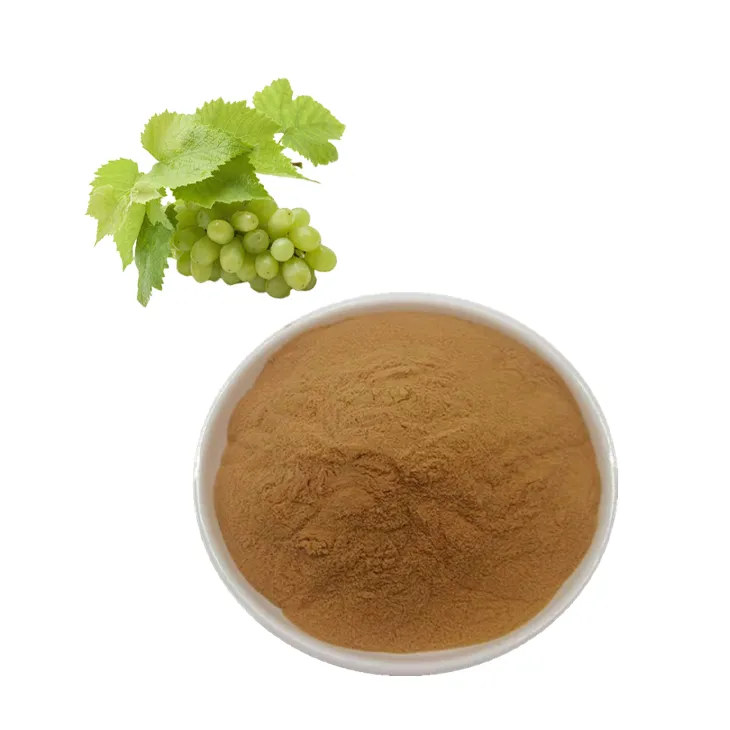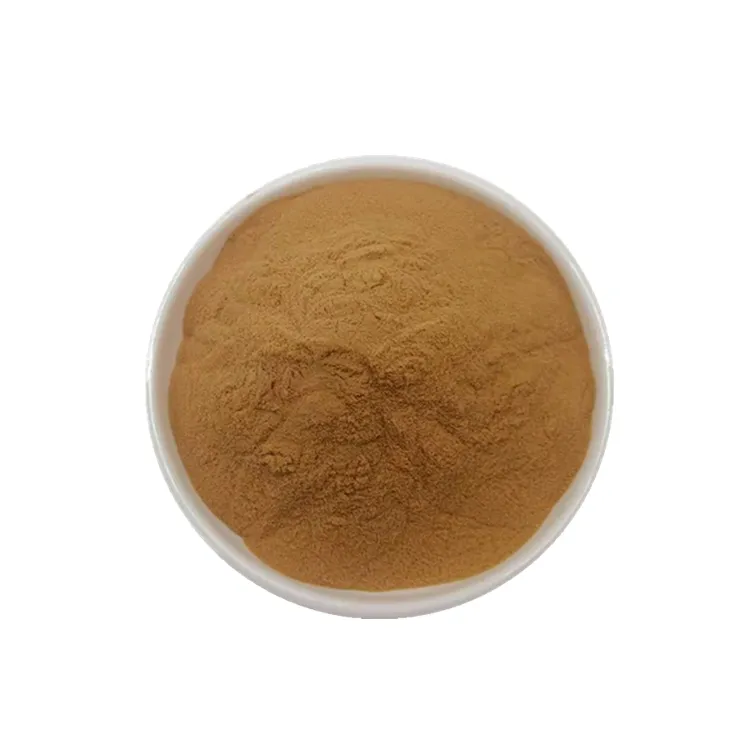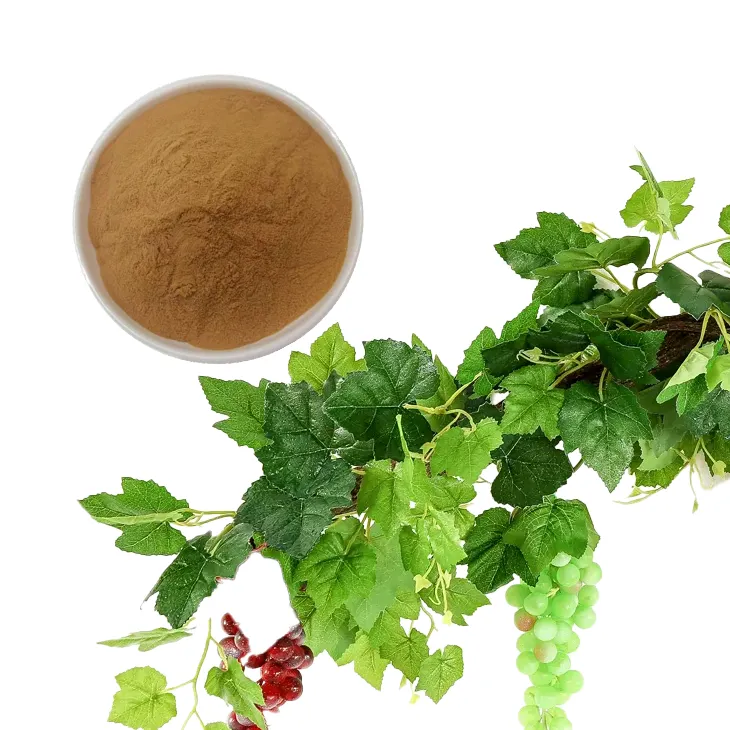- 0086-571-85302990
- sales@greenskybio.com
The process of extracting grape leaf polyphenols from grape leaf extract.
2024-11-30

1. Introduction
Grape leaf polyphenols have attracted significant attention in recent years due to their potential applications in various fields, especially in health and cosmetics. Polyphenols are a large group of phytochemicals that possess antioxidant, anti - inflammatory, and antimicrobial properties. Grape leaves, which are often considered as agricultural waste, are a rich source of these valuable polyphenols.

2. Grape Leaves as Raw Materials
2.1 Collection and Selection
Grape leaves should be collected at the appropriate time. Usually, younger leaves are preferred as they tend to have a higher content of polyphenols. The leaves should be free from diseases, pests, and any signs of chemical contamination. After collection, they need to be sorted carefully to remove any damaged or withered parts.2.2 Pretreatment
Once selected, the grape leaves require pretreatment before extraction. This may involve washing the leaves thoroughly to remove dirt, dust, and any surface impurities. Subsequently, the leaves can be dried. Drying can be carried out using natural air - drying or in a low - temperature oven. This step is crucial as it helps in preserving the polyphenols and also makes the extraction process more efficient.
3. Initial Extraction to Obtain Grape Leaf Extracts
3.1 Solvent Extraction
Solvent extraction is one of the most common methods for obtaining Grape Leaf Extracts. Ethanol and methanol are often used as solvents due to their ability to dissolve polyphenols effectively. The process involves grinding the dried grape leaves into a fine powder and then mixing it with the solvent in a suitable ratio. For example, a ratio of 1:10 (leaf powder: solvent) can be used. The mixture is then stirred continuously for a certain period, usually several hours at room temperature or slightly elevated temperatures. After that, the mixture is filtered to separate the liquid extract from the solid residue.3.2 Supercritical Fluid Extraction
Supercritical fluid extraction (SFE) is another emerging method. Carbon dioxide (CO₂) is often used as the supercritical fluid. Under specific pressure and temperature conditions, CO₂ reaches its supercritical state, which has properties between those of a gas and a liquid. This allows it to penetrate the plant material and extract the polyphenols more selectively. The advantage of SFE is that it is a cleaner process compared to solvent extraction, as there is no solvent residue left in the final product. However, the equipment required for SFE is more expensive.
4. Techniques for Isolating Polyphenols from Extracts
4.1 Solvent - Solvent Partitioning
Solvent - solvent partitioning is a simple yet effective method for further purifying polyphenols from the initial extract. Different solvents are used based on their polarity. For example, a non - polar solvent like hexane can be used to remove non - polar impurities from the extract. Then, a more polar solvent can be used to isolate the polyphenols. This method takes advantage of the fact that polyphenols have different solubility characteristics in different solvents.4.2 Chromatography Methods
- High - Performance Liquid Chromatography (HPLC): HPLC is a widely used technique for separating and analyzing polyphenols. It uses a high - pressure pump to pass the sample (the Grape Leaf Extract) through a column filled with a stationary phase. Different polyphenols will interact differently with the stationary phase and the mobile phase (the solvent), resulting in their separation. HPLC can provide highly accurate and reproducible results, allowing for the identification and quantification of individual polyphenols in the extract.
- Gas Chromatography (GC): GC is mainly used for analyzing volatile polyphenols or those that can be derivatized to become volatile. The sample is vaporized and carried by an inert gas through a column. The separation is based on the different affinities of the components for the stationary phase in the column. However, GC requires more sample preparation compared to HPLC, especially for non - volatile polyphenols.
5. Factors Affecting Extraction Efficiency
5.1 Temperature
Temperature plays a crucial role in the extraction process. Generally, an increase in temperature can enhance the solubility of polyphenols in the solvent, thus increasing the extraction efficiency. However, if the temperature is too high, it may cause degradation of polyphenols. For example, in solvent extraction, when using ethanol as the solvent, an optimal temperature range might be between 40 - 60°C. Above this range, the antioxidant activity of some polyphenols may start to decrease due to thermal degradation.5.2 pH Value
The pH value of the extraction medium also affects the extraction efficiency. Different polyphenols have different stability at different pH values. For most grape leaf polyphenols, a slightly acidic pH (around pH 4 - 6) is often favorable for extraction. At this pH range, the polyphenols are more stable and can be more effectively extracted from the plant material. If the pH is too alkaline or too acidic, it may lead to the chemical transformation or degradation of polyphenols.5.3 Extraction Time
The extraction time is another important factor. Longer extraction times usually result in higher yields of polyphenols up to a certain point. However, after an extended period, the extraction efficiency may not increase significantly and may even start to decline due to the degradation of polyphenols or the saturation of the solvent. For example, in solvent extraction with ethanol, an extraction time of 2 - 4 hours may be sufficient to extract a large amount of polyphenols, but extending the time beyond 6 hours may not lead to a substantial increase in the yield.6. Conclusion
The extraction of grape leaf polyphenols from grape leaf extracts is a multi - step process that involves careful selection and pretreatment of raw materials, initial extraction methods, and further isolation techniques. Understanding the factors that affect extraction efficiency, such as temperature, pH value, and extraction time, is crucial for optimizing the extraction process. With the increasing demand for natural products with health - promoting and cosmetic properties, the extraction of grape leaf polyphenols has great potential for further development and application in various industries.
FAQ:
What are the main initial extraction methods for obtaining grape leaf extracts?
Common initial extraction methods for obtaining grape leaf extracts include maceration and Soxhlet extraction. Maceration involves soaking the grape leaves in a suitable solvent for a period of time to allow the soluble components to dissolve. Soxhlet extraction is a continuous extraction method that can more effectively extract the components from the grape leaves using a solvent reflux system.
How does solvent extraction work in isolating grape leaf polyphenols from the extract?
Solvent extraction for isolating grape leaf polyphenols works based on the principle of solubility differences. Different solvents are chosen based on the chemical properties of polyphenols. For example, polar solvents like ethanol or methanol are often used as polyphenols are generally more soluble in polar solvents. The extract is mixed with the solvent, and after proper agitation and separation, the polyphenols are transferred into the solvent phase, which can then be further processed to obtain relatively pure polyphenols.
What role does chromatography play in the extraction of grape leaf polyphenols?
Chromatography is a very important technique in the extraction of grape leaf polyphenols. It can separate different types of polyphenols based on their different affinities to the stationary phase and the mobile phase. For example, in high - performance liquid chromatography (HPLC), the sample (the extract containing polyphenols) is passed through a column filled with a specific stationary phase. Different polyphenols will elute at different times depending on their interaction with the stationary and mobile phases, allowing for the isolation and identification of individual polyphenols.
How do temperature, pH value, and extraction time affect the extraction efficiency of grape leaf polyphenols?
Temperature can significantly affect the extraction efficiency. Higher temperatures generally increase the solubility of polyphenols and the rate of mass transfer, but if the temperature is too high, it may cause degradation of polyphenols. The pH value also plays a role. Different polyphenols may have different stabilities at different pH levels. For example, some polyphenols are more stable in slightly acidic conditions. Extraction time is another factor. Longer extraction times may increase the yield of polyphenols to a certain extent, but after a certain point, the increase may be minimal or may even lead to the extraction of unwanted impurities.
Why are grape leaf polyphenols important in the health and cosmetics fields?
In the health field, grape leaf polyphenols have antioxidant properties. They can scavenge free radicals in the body, which are associated with various diseases such as cancer and cardiovascular diseases. Antioxidants help protect cells from oxidative damage. In the cosmetics field, polyphenols can also act as antioxidants, protecting the skin from environmental damage such as UV radiation. They may also have anti - inflammatory properties, which can be beneficial for treating skin conditions and maintaining skin health.
Related literature
- Extraction and Characterization of Polyphenols from Grape Leaves: A Review"
- "Optimization of Grape Leaf Polyphenol Extraction for Potential Health Applications"
- "The Role of Grape Leaf Polyphenols in Cosmetics: Extraction and Efficacy"
- ▶ Hesperidin
- ▶ Citrus Bioflavonoids
- ▶ Plant Extract
- ▶ lycopene
- ▶ Diosmin
- ▶ Grape seed extract
- ▶ Sea buckthorn Juice Powder
- ▶ Fruit Juice Powder
- ▶ Hops Extract
- ▶ Artichoke Extract
- ▶ Mushroom extract
- ▶ Astaxanthin
- ▶ Green Tea Extract
- ▶ Curcumin
- ▶ Horse Chestnut Extract
- ▶ Other Product
- ▶ Boswellia Serrata Extract
- ▶ Resveratrol
- ▶ Marigold Extract
- ▶ Grape Leaf Extract
- ▶ New Product
- ▶ Aminolevulinic acid
- ▶ Cranberry Extract
- ▶ Red Yeast Rice
- ▶ Red Wine Extract
-
Giant Knotweed Extract
2024-11-30
-
Curcuma Longa Extract
2024-11-30
-
Andrographis Paniculata Extract Powder
2024-11-30
-
Angelica sinensis extract
2024-11-30
-
Kidney Bean Extract
2024-11-30
-
Europen Bilberry Extract
2024-11-30
-
Citrus Aurantium Extract
2024-11-30
-
Reishi mushroom extract
2024-11-30
-
Pueraria Lobata Extract
2024-11-30
-
Chia Seed Powder
2024-11-30





















